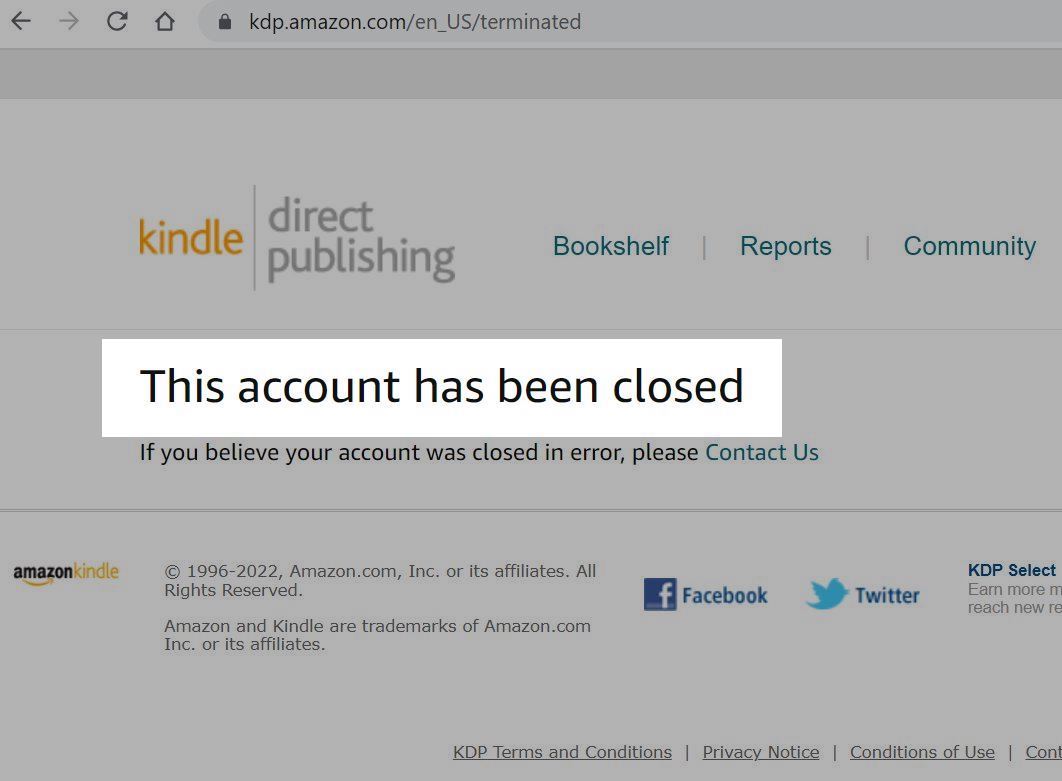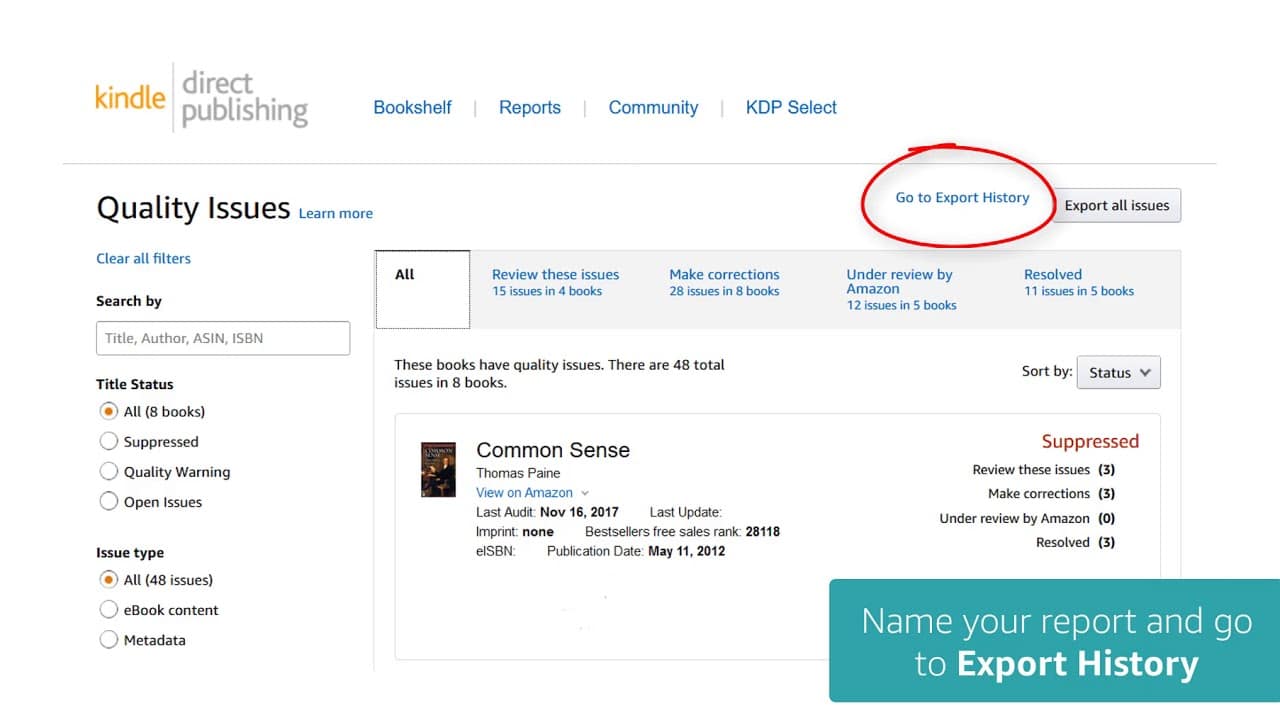
Amazon Kindle Direct Publishing (KDP) has revolutionized self-publishing, enabling authors and creators to bring their works to a global audience with ease. As we all know, this platform is particularly popular for “no-” and “low-” content books, such as coloring books, puzzle books, trivia books, children’s activity books, and journals. However, like any digital platform, KDP has rules and policies that users must adhere to. Violations of these policies can lead to account termination, which can be a significant setback for creators.
A recent scan of Book Bolt Studio’s Facebook page shows this as a frequent topic. In this article, we’ll explore the reasons why a KDP account might be terminated and the steps a KDP’er can take to try and get their account reinstated.
Common Reasons for KDP Account Termination
Understanding the reasons behind KDP account terminations is the first step in preventing them. Here are some of the most common causes:
- Copyright Infringement: One of the primary reasons for account termination is the publication of content that infringes on someone else’s copyright. This includes using images, text, or other content without proper authorization.
- Duplicate Content: KDP has strict policies against publishing duplicate content. This means that republishing the same or very similar content across multiple books can lead to termination. This policy is in place to prevent spam and maintain the quality of content on the platform.
- Poor Content Quality: Books with poor formatting, low-resolution images, or significant grammatical errors can be flagged for poor quality. Consistently publishing low-quality content can result in account termination.
- Manipulating Sales and Reviews: Engaging in practices that manipulate sales rankings or customer reviews, such as purchasing your own books in bulk or incentivizing reviews, is strictly prohibited and can lead to account termination.
- Misleading Metadata: Using misleading or irrelevant keywords, titles, or descriptions to increase the visibility of your books violates KDP’s policies. This includes keyword stuffing or using unrelated popular keywords.
- Violating Content Guidelines: KDP has specific content guidelines regarding adult content, offensive material, and prohibited subjects. Publishing books that violate these guidelines can result in account termination.
- Multiple Account Violations: Operating multiple KDP accounts without permission from Amazon is against the platform’s terms of service. If Amazon discovers that an individual is managing multiple accounts, it can lead to termination of all associated accounts.
Steps to Take if Your KDP Account is Terminated
Discovering that your KDP account has been terminated can be a stressful experience, but there are steps you can take to try and resolve the situation. Here’s a guide to navigating the process:
- Review the Termination Notice: Carefully read the email or notification from Amazon regarding the termination. It will often provide specific reasons for the account closure. Understanding the exact cause is crucial for addressing the issue effectively.
- Assess Your Content: Once you know the reason for termination, review your content to identify any violations. This may involve checking for copyright infringements, duplicate content, or any other issues mentioned in the termination notice.
- Gather Evidence: If you believe the termination was a mistake, gather evidence to support your case. This could include proof of rights to use certain content, screenshots of your metadata, or examples of similar content that has been allowed on the platform.
- Contact KDP Support: Reach out to KDP support through their official channels. Be polite and professional in your communication. Explain your situation clearly and provide any evidence you have gathered. It’s important to address the specific reasons mentioned in the termination notice.
- Appeal the Decision: If your initial contact with KDP support doesn’t resolve the issue, you may need to file a formal appeal. This involves submitting a detailed explanation of why you believe the termination was unjustified and providing all relevant evidence. Be thorough and concise in your appeal.
- Rectify the Issue: If the termination was due to a legitimate violation, take steps to rectify the issue. This could involve removing infringing content, improving the quality of your books, or adjusting your metadata to comply with KDP’s guidelines. Once you have made the necessary changes, inform KDP support of your actions and request reconsideration.
- Monitor Your Email: After submitting your appeal, monitor your email closely for any responses from KDP support. They may request additional information or provide further instructions. Respond promptly to any requests to keep the process moving forward.
- Seek Legal Advice: In some cases, it may be beneficial to seek legal advice, especially if you believe your rights have been violated or if the situation is complex. A lawyer with experience in intellectual property and digital publishing can provide valuable guidance.
Tips for Preventing Future Terminations
To avoid the stress and disruption of account termination, it’s essential to adhere to KDP’s policies and best practices. Here are some tips to help you maintain a healthy and compliant KDP account:
- Understand KDP’s Guidelines: Familiarize yourself with KDP’s content and community guidelines. Regularly review these guidelines to ensure your content and practices remain compliant.
- Maintain High-Quality Standards: Invest time in creating high-quality books with good formatting, clear images, and error-free text. Quality content not only reduces the risk of termination but also enhances customer satisfaction and sales.
- Respect Copyright Laws: Always ensure that you have the necessary rights to use any content in your books. This includes obtaining licenses for images, verifying the originality of your text, and respecting trademarks.
- Avoid Duplicate Content: Be mindful of KDP’s policies on duplicate content. Each book should offer unique value to readers. If you’re creating variations of a book, ensure that each version is significantly different from the others.
- Be Honest in Metadata: Use accurate and relevant keywords, titles, and descriptions for your books. Avoid misleading or manipulative practices that could be perceived as attempting to game the system.
- Engage in Ethical Marketing: Promote your books ethically without resorting to practices that could be seen as manipulating sales or reviews. Encourage genuine customer feedback and avoid incentivizing reviews.
- Monitor Your Account: Regularly review your account for any notifications or warnings from KDP. Address any issues promptly to prevent them from escalating to the point of termination.
The Road to Reinstatement
Reinstating a terminated KDP account can be challenging, but many authors and creators have successfully navigated the process. Patience, persistence, and a commitment to complying with KDP’s guidelines are key to overcoming this hurdle. By understanding the reasons behind terminations and taking proactive steps to prevent violations, you can safeguard your KDP account and continue to bring your creative works to a global audience.
Conclusion
Amazon Kindle Direct Publishing offers incredible opportunities for creators of “no-” and “low-” content books, but it’s crucial to play by the rules. Understanding the common reasons for account termination and knowing the steps to take if your account is closed can help you navigate this aspect of self-publishing. By maintaining high standards, respecting copyright laws, and adhering to KDP’s guidelines, you can minimize the risk of termination and enjoy a successful publishing journey on this platform.


